fuses SAAB 9-3 2002 Owners Manual
[x] Cancel search | Manufacturer: SAAB, Model Year: 2002, Model line: 9-3, Model: SAAB 9-3 2002Pages: 256, PDF Size: 11.55 MB
Page 6 of 256
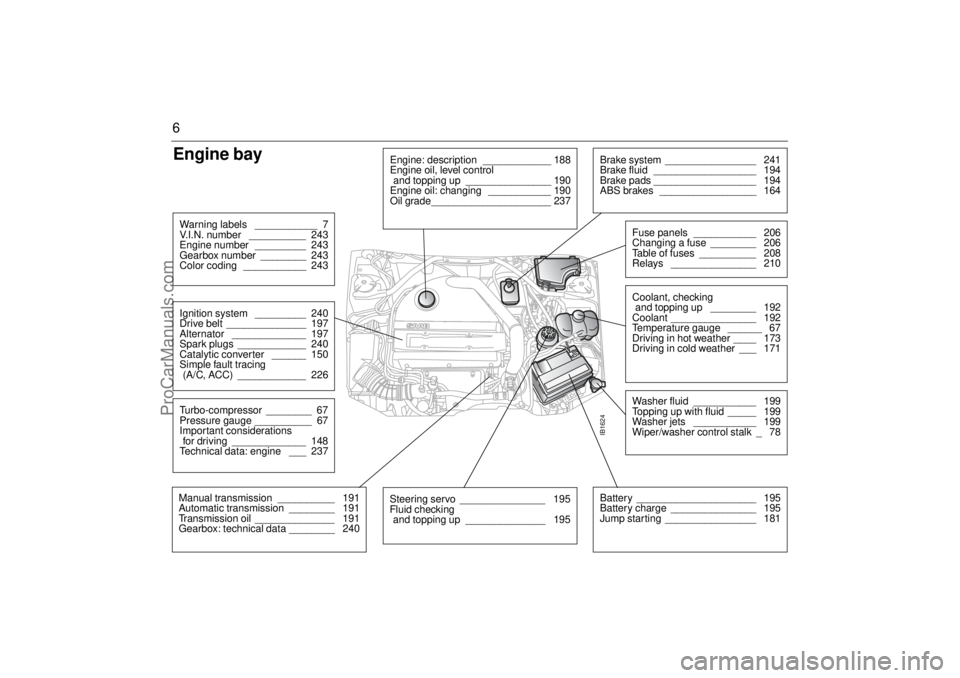
6Engine bayWarning labels ___________ 7
V.I.N. number __________ 243
Engine number _________ 243
Gearbox number ________ 243
Color coding ___________ 243Ignition system _________ 240
Drive belt ______________ 197
Alternator _____________ 197
Spark plugs ____________ 240
Catalytic converter ______ 150
Simple fault tracing
(A/C, ACC) ____________ 226Turbo-compressor ________ 67
Pressure gauge __________ 67
Important considerations
for driving _____________ 148
Technical data: engine ___ 237Manual transmission __________ 191
Automatic transmission ________ 191
Transmission oil ______________ 191
Gearbox: technical data ________ 240
Battery _____________________ 195
Battery charge _______________ 195
Jump starting ________________ 181IB1624
Engine: description ____________ 188
Engine oil, level control
and topping up _______________ 190
Engine oil: changing ___________ 190
Oil grade_____________________ 237
Washer fluid ___________ 199
Topping up with fluid _____ 199
Washer jets ___________ 199
Wiper/washer control stalk _ 78
Steering servo _______________ 195
Fluid checking
and topping up ______________ 195
Coolant, checking
and topping up ________ 192
Coolant _______________ 192
Temperature gauge ______ 67
Driving in hot weather ____ 173
Driving in cold weather ___ 171Fuse panels ___________ 206
Changing a fuse ________ 206
Table of fuses __________ 208
Relays _______________ 210
Brake system ________________ 241
Brake fluid __________________ 194
Brake pads __________________ 194
ABS brakes _________________ 164
ProCarManuals.com
Page 55 of 256
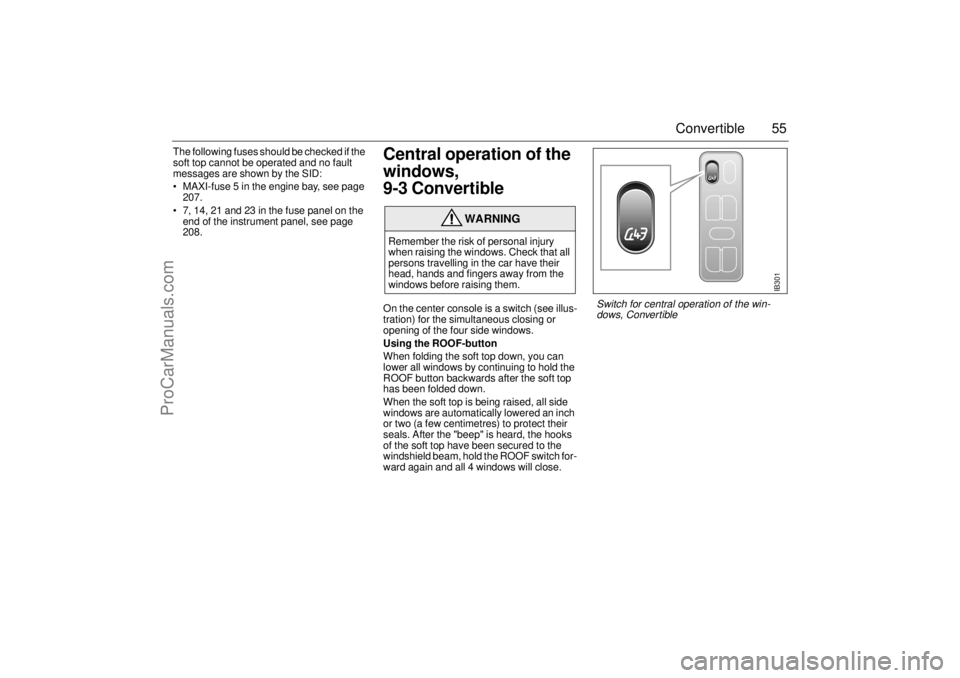
55 Convertible
The following fuses should be checked if the
soft top cannot be operated and no fault
messages are shown by the SID:
MAXI-fuse 5 in the engine bay, see page
207.
7, 14, 21 and 23 in the fuse panel on the
end of the instrument panel, see page
208.
Central operation of the
windows,
9-3 ConvertibleOn the center console is a switch (see illus-
tration) for the simultaneous closing or
opening of the four side windows.
Using the ROOF-button
When folding the soft top down, you can
lower all windows by continuing to hold the
ROOF button backwards after the soft top
has been folded down.
When the soft top is being raised, all side
windows are automatically lowered an inch
or two (a few centimetres) to protect their
seals. After the "beep" is heard, the hooks
of the soft top have been secured to the
windshield beam, hold the ROOF switch for-
ward again and all 4 windows will close.
WARNING
Remember the risk of personal injury
when raising the windows. Check that all
persons travelling in the car have their
head, hands and fingers away from the
windows before raising them.
IB301
Switch for central operation of the win-
dows, Conver tible
ProCarManuals.com
Page 147 of 256
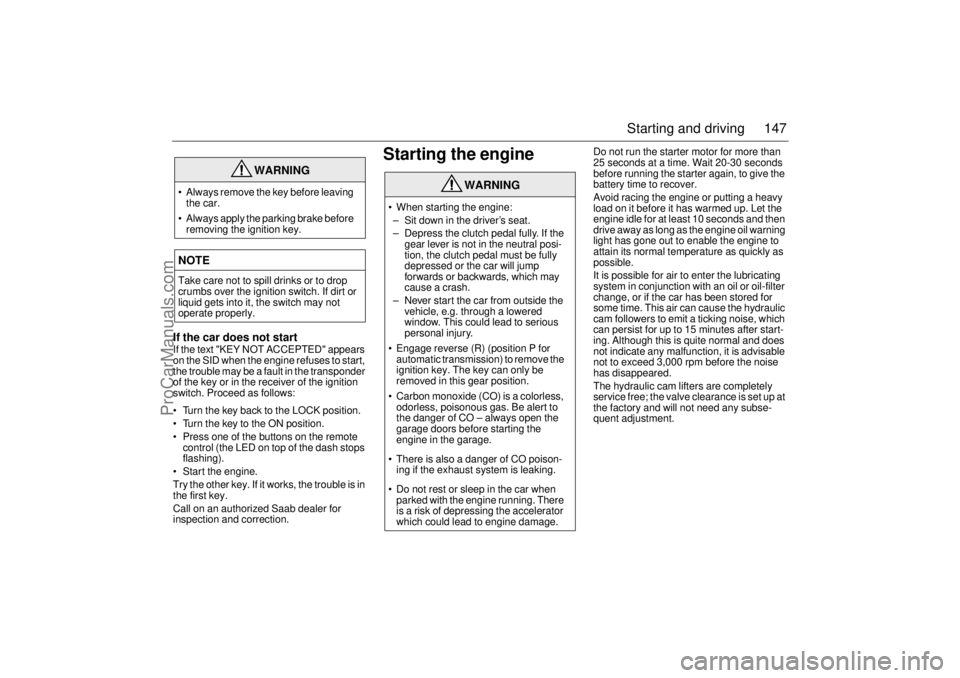
147 Starting and driving
If the car does not startIf the text "KEY NOT ACCEPTED" appears
on the SID when the engine refuses to start,
the trouble may be a fault in the transponder
of the key or in the receiver of the ignition
switch. Proceed as follows:
• Turn the key back to the LOCK position.
Turn the key to the ON position.
Press one of the buttons on the remote
control (the LED on top of the dash stops
flashing).
Start the engine.
Try the other key. If it works, the trouble is in
the first key.
Call on an authorized Saab dealer for
inspection and correction.
Starting the engine
Do not run the starter motor for more than
25 seconds at a time. Wait 20-30 seconds
before running the starter again, to give the
battery time to recover.
Avoid racing the engine or putting a heavy
load on it before it has warmed up. Let the
engine idle for at least 10 seconds and then
drive away as long as the engine oil warning
light has gone out to enable the engine to
attain its normal temperature as quickly as
possible.
It is possible for air to enter the lubricating
system in conjunction with an oil or oil-filter
change, or if the car has been stored for
some time. This air can cause the hydraulic
cam followers to emit a ticking noise, which
can persist for up to 15 minutes after start-
ing. Although this is quite normal and does
not indicate any malfunction, it is advisable
not to exceed 3,000 rpm before the noise
has disappeared.
The hydraulic cam lifters are completely
service free; the valve clearance is set up at
the factory and will not need any subse-
quent adjustment.
WARNING
Always remove the key before leaving
the car.
Always apply the parking brake before
removing the ignition key.NOTETake care not to spill drinks or to drop
crumbs over the ignition switch. If dirt or
liquid gets into it, the switch may not
operate properly.
WARNING
When starting the engine:
– Sit down in the driver’s seat.
– Depress the clutch pedal fully. If the
gear lever is not in the neutral posi-
tion, the clutch pedal must be fully
depressed or the car will jump
forwards or backwards, which may
cause a crash.
– Never start the car from outside the
vehicle, e.g. through a lowered
window. This could lead to serious
personal injury.
Engage reverse (R) (position P for
automatic transmission) to remove the
ignition key. The key can only be
removed in this gear position.
Carbon monoxide (CO) is a colorless,
odorless, poisonous gas. Be alert to
the danger of CO – always open the
garage doors before starting the
engine in the garage.
There is also a danger of CO poison-
ing if the exhaust system is leaking.
Do not rest or sleep in the car when
parked with the engine running. There
is a risk of depressing the accelerator
which could lead to engine damage.
ProCarManuals.com
Page 184 of 256
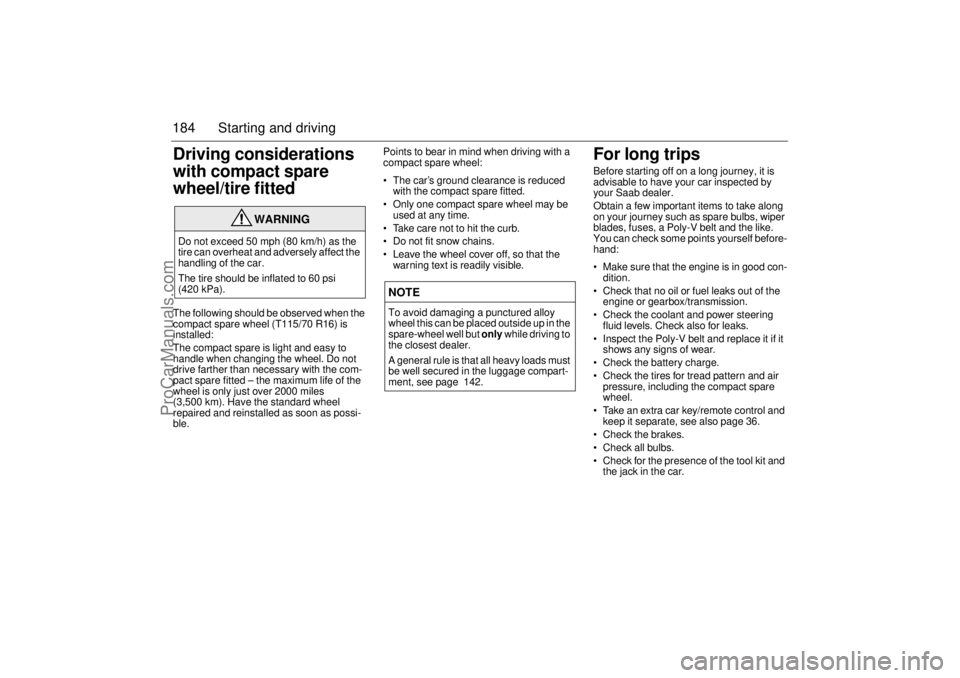
184 Starting and drivingDriving considerations
with compact spare
wheel/tire fitted The following should be observed when the
compact spare wheel (T115/70 R16) is
installed:
The compact spare is light and easy to
handle when changing the wheel. Do not
drive farther than necessary with the com-
pact spare fitted – the maximum life of the
wheel is only just over 2000 miles
(3,500 km). Have the standard wheel
repaired and reinstalled as soon as possi-
ble.Points to bear in mind when driving with a
compact spare wheel:
The car’s ground clearance is reduced
with the compact spare fitted.
Only one compact spare wheel may be
used at any time.
Take care not to hit the curb.
Do not fit snow chains.
Leave the wheel cover off, so that the
warning text is readily visible.
For long tripsBefore starting off on a long journey, it is
advisable to have your car inspected by
your Saab dealer.
Obtain a few important items to take along
on your journey such as spare bulbs, wiper
blades, fuses, a Poly-V belt and the like.
You can check some points yourself before-
hand:
Make sure that the engine is in good con-
dition.
Check that no oil or fuel leaks out of the
engine or gearbox/transmission.
Check the coolant and power steering
fluid levels. Check also for leaks.
Inspect the Poly-V belt and replace it if it
shows any signs of wear.
Check the battery charge.
Check the tires for tread pattern and air
pressure, including the compact spare
wheel.
Take an extra car key/remote control and
keep it separate, see also page 36.
Check the brakes.
Check all bulbs.
Check for the presence of the tool kit and
the jack in the car.
WARNING
Do not exceed 50 mph (80 km/h) as the
tire can overheat and adversely affect the
handling of the car.
The tire should be inflated to 60 psi
(420 kPa).
NOTETo avoid damaging a punctured alloy
wheel this can be placed outside up in the
spare-wheel well but only while driving to
the closest dealer.
A general rule is that all heavy loads must
be well secured in the luggage compart-
ment, see page 142.
ProCarManuals.com
Page 185 of 256
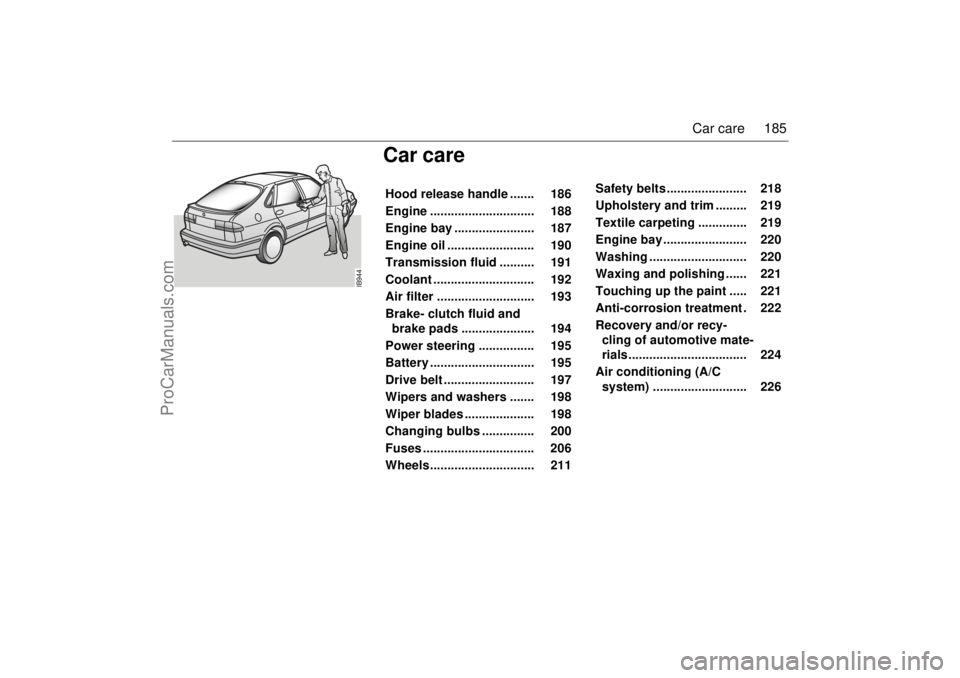
185 Car care
IB944
Hood release handle ....... 186
Engine .............................. 188
Engine bay ....................... 187
Engine oil ......................... 190
Transmission fluid .......... 191
Coolant ............................. 192
Air filter ............................ 193
Brake- clutch fluid and
brake pads ..................... 194
Power steering ................ 195
Battery .............................. 195
Drive belt .......................... 197
Wipers and washers ....... 198
Wiper blades .................... 198
Changing bulbs ............... 200
Fuses ................................ 206
Wheels.............................. 211 Safety belts ....................... 218
Upholstery and trim ......... 219
Textile carpeting .............. 219
Engine bay ........................ 220
Washing ............................ 220
Waxing and polishing ...... 221
Touching up the paint ..... 221
Anti-corrosion treatment . 222
Recovery and/or recy-
cling of automotive mate-
rials .................................. 224
Air conditioning (A/C
system) ........................... 226 Car care
ProCarManuals.com
Page 187 of 256
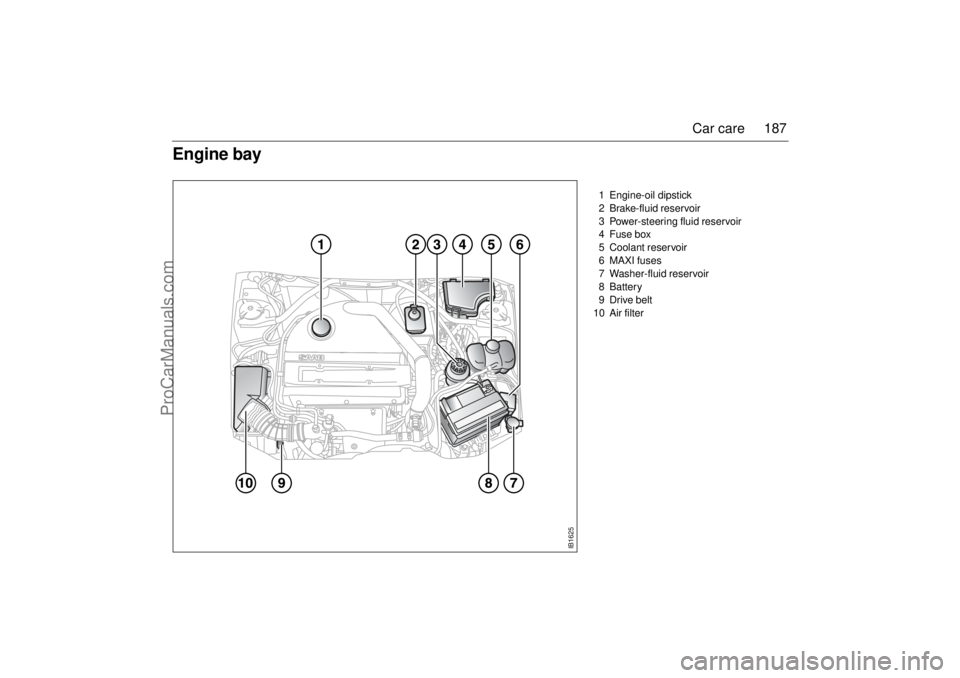
187 Car care
1 Engine-oil dipstick
2 Brake-fluid reservoir
3 Power-steering fluid reservoir
4 Fuse box
5 Coolant reservoir
6 MAXI fuses
7 Washer-fluid reservoir
8Battery
9Drive belt
10 Air filter
Engine bay
IB1625
ProCarManuals.com
Page 206 of 256
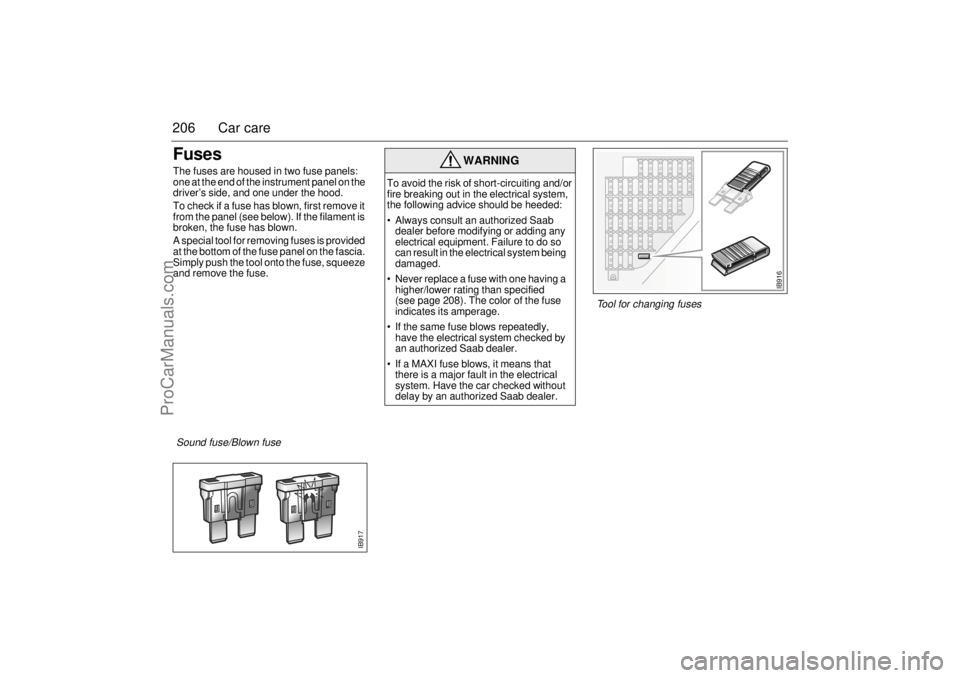
206 Car careFusesThe fuses are housed in two fuse panels:
one at the end of the instrument panel on the
driver’s side, and one under the hood.
To check if a fuse has blown, first remove it
from the panel (see below). If the filament is
broken, the fuse has blown.
A special tool for removing fuses is provided
at the bottom of the fuse panel on the fascia.
Simply push the tool onto the fuse, squeeze
and remove the fuse.
WARNING
To avoid the risk of short-circuiting and/or
fire breaking out in the electrical system,
the following advice should be heeded:
Always consult an authorized Saab
dealer before modifying or adding any
electrical equipment. Failure to do so
can result in the electrical system being
damaged.
Never replace a fuse with one having a
higher/lower rating than specified
(see page 208). The color of the fuse
indicates its amperage.
If the same fuse blows repeatedly,
have the electrical system checked by
an authorized Saab dealer.
If a MAXI fuse blows, it means that
there is a major fault in the electrical
system. Have the car checked without
delay by an authorized Saab dealer.
301020303015
15151010101010
1030301020151515
101020202020201515
301515101515
IB916
IB917
Sound fuse/Blown fuse Tool for changing fuses
ProCarManuals.com
Page 207 of 256
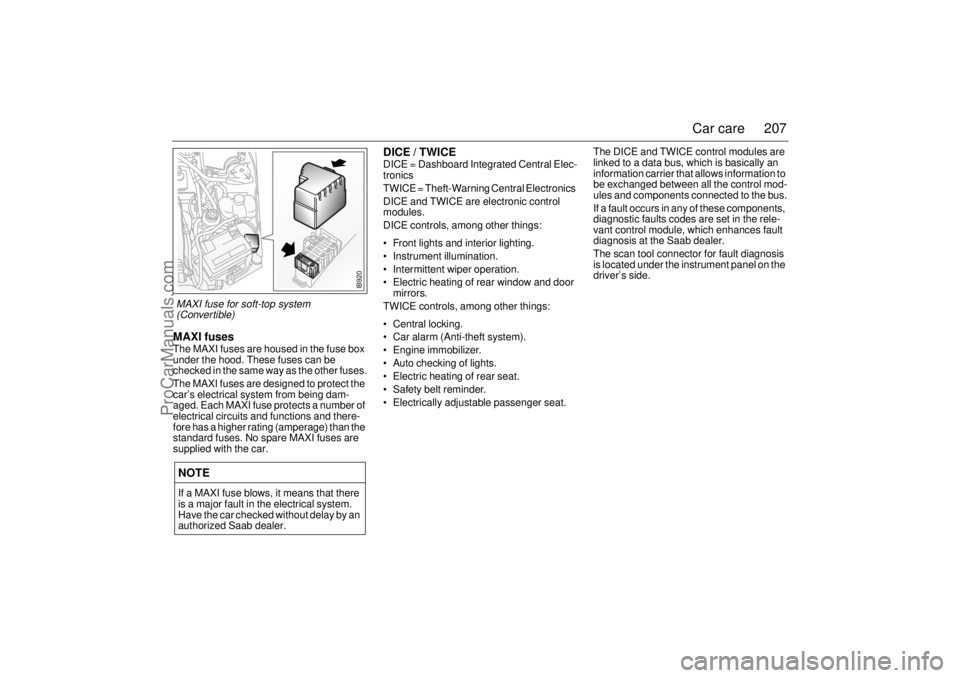
207 Car care
MAXI fusesThe MAXI fuses are housed in the fuse box
under the hood. These fuses can be
checked in the same way as the other fuses.
The MAXI fuses are designed to protect the
car’s electrical system from being dam-
aged. Each MAXI fuse protects a number of
electrical circuits and functions and there-
fore has a higher rating (amperage) than the
standard fuses. No spare MAXI fuses are
supplied with the car.
DICE / TWICEDICE = Dashboard Integrated Central Elec-
tronics
TWICE = Theft-Warning Central Electronics
DICE and TWICE are electronic control
modules.
DICE controls, among other things:
Front lights and interior lighting.
Instrument illumination.
Intermittent wiper operation.
Electric heating of rear window and door
mirrors.
TWICE controls, among other things:
Central locking.
Car alarm (Anti-theft system).
Engine immobilizer.
Auto checking of lights.
Electric heating of rear seat.
Safety belt reminder.
Electrically adjustable passenger seat.The DICE and TWICE control modules are
linked to a data bus, which is basically an
information carrier that allows information to
be exchanged between all the control mod-
ules and components connected to the bus.
If a fault occurs in any of these components,
diagnostic faults codes are set in the rele-
vant control module, which enhances fault
diagnosis at the Saab dealer.
The scan tool connector for fault diagnosis
is located under the instrument panel on the
driver’s side.
NOTEIf a MAXI fuse blows, it means that there
is a major fault in the electrical system.
Have the car checked without delay by an
authorized Saab dealer.
IB920
MAXI fuse for soft-top system
(Convertible)
ProCarManuals.com
Page 208 of 256
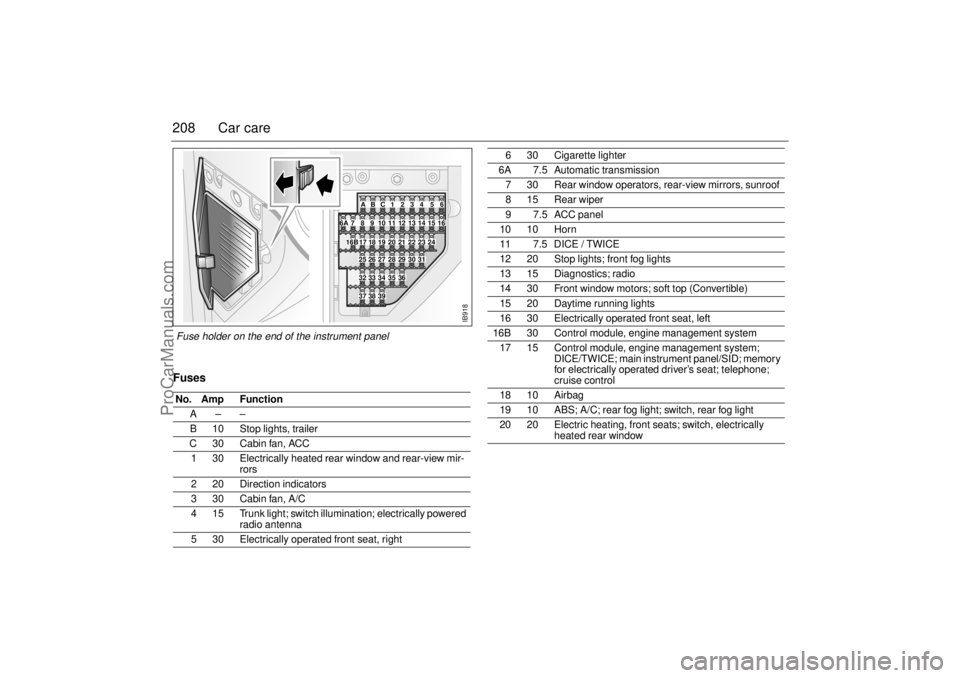
208 Car careFusesNo. Amp Function
A––
B 10 Stop lights, trailer
C 30 Cabin fan, ACC
1 30 Electrically heated rear window and rear-view mir-
rors
220Direction indicators
330Cabin fan, A/C
4 15 Trunk light; switch illumination; electrically powered
radio antenna
5 30 Electrically operated front seat, right
6 30 Cigarette lighter
6A 7.5 Automatic transmission
7 30 Rear window operators, rear-view mirrors, sunroof
8 15 Rear wiper
9 7.5 ACC panel
10 10 Horn
11 7.5 DICE / TWICE
12 20 Stop lights; front fog lights
13 15 Diagnostics; radio
14 30 Front window motors; soft top (Convertible)
15 20 Daytime running lights
16 30 Electrically operated front seat, left
16B 30 Control module, engine management system
17 15 Control module, engine management system;
DICE/TWICE; main instrument panel/SID; memory
for electrically operated driver’s seat; telephone;
cruise control
18 10 Airbag
19 10 ABS; A/C; rear fog light; switch, rear fog light
20 20 Electric heating, front seats; switch, electrically
heated rear window
30 10 20
30 30 15
15 15
10 10 10
10
10
10 30
30 10 20
15
15
15
10 10
20
10 20 20
20 20 15
15
30 15
15 10 15
15
IB918
1 C B A23456
7 6A 8 9 10 11 12 13 14 15 16
17 16B 18 19 20 21 22 23 2425 26 27 28 29 30 3132 33 34 35 3637 38 39
Fuse holder on the end of the instrument panel
ProCarManuals.com
Page 210 of 256
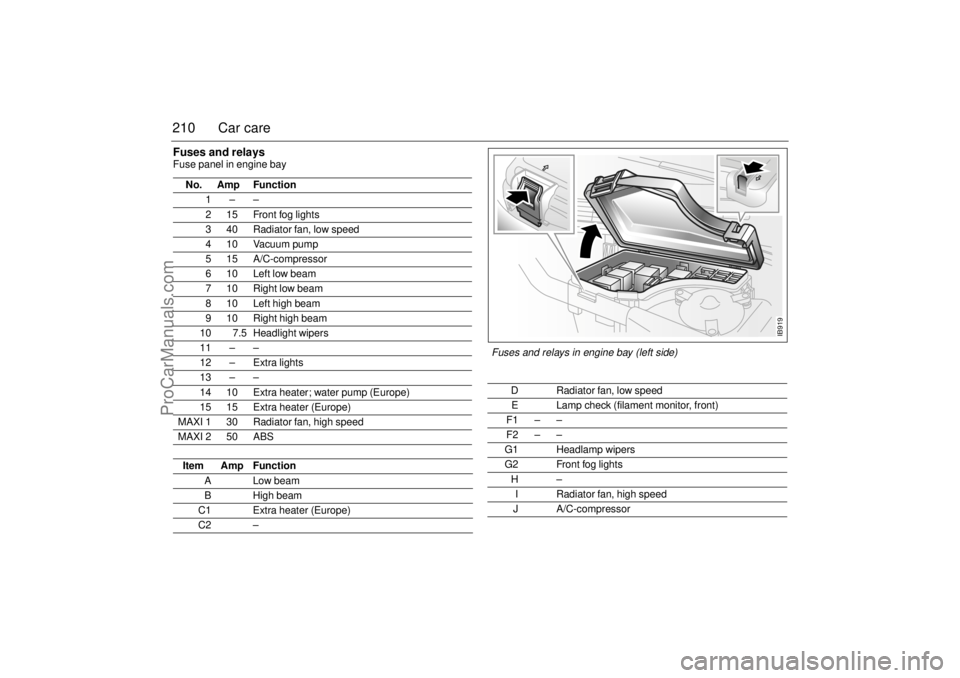
210 Car careFuses and relays Fuse panel in engine bay
No. Amp Function
1––
2 15 Front fog lights
3 40 Radiator fan, low speed
4 10 Vacuum pump
5 15 A/C-compressor
610Left low beam
7 10 Right low beam
8 10 Left high beam
9 10 Right high beam
10 7.5 Headlight wipers
11 – –
12 – Extra lights
13 – –
14 10 Extra heater; water pump (Europe)
15 15 Extra heater (Europe)
MAXI 1 30 Radiator fan, high speed
MAXI 2 50 ABS
Item Amp Function
A Low beam
B High beam
C1 Extra heater (Europe)
C2 –
D Radiator fan, low speed
E Lamp check (filament monitor, front)
F1 – –
F2 – –
G1 Headlamp wipers
G2 Front fog lights
H–
I Radiator fan, high speed
J A/C-compressor
IB919
Fuses and relays in engine bay (left side)
ProCarManuals.com